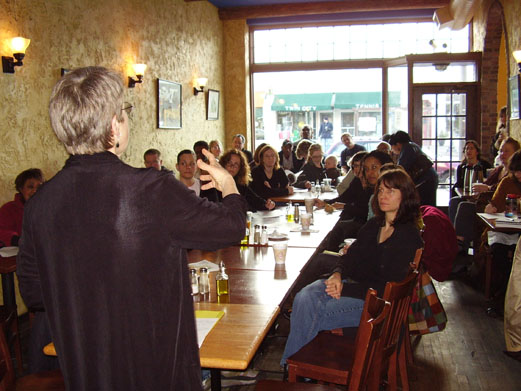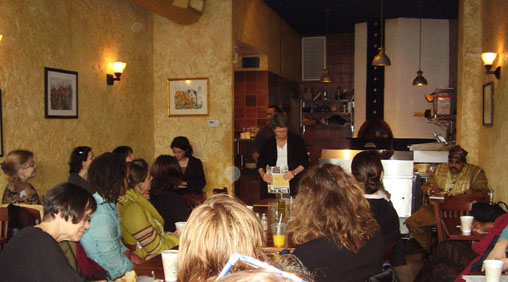The Spokes, the Hub, the Wheel: Arts as Part of Neighborhoods
Shannon Gibney reports on a recent get-together among 8th Ward artists, researcher Ann Markusen, and city council member Elizabeth Glidden.


Although the Twin Cities is a nationally recognized hub for arts activities, University of Minnesota economist Ann Markusen told a group of Ward 8 artists who recently gathered at the Turtle Bread Company in South Minneapolis, that the metro could do much, much better. (Minneapolis Ward 8 in its new incarnation reaches from Lake Street on the north to 50th Street on the south, and from Cedar on the east to Lyndale Avenue on the West.)
“We don’t have a very good arts planning community,” said Markusen, at an arts and community forum that Minneapolis Ward 8 Council Member Elizabeth Glidden organized for artists in her ward, on Friday, March 23. “The City should have a portfolio approach,” Markusen continued. “Let’s put out all the various things we can invest in, and then have a public debate about it. That way, we would have a strategy that would serve all neighborhoods.”
Markusen said that right now, elites in cities overwhelm funding received, which is a huge problem in terms of what we now know works to create artistically vibrant cities. “The cities that have done the best in this area are Chicago, New York, Seattle (which is about our size) and San Francisco, because they have cultural centers embedded in neighborhoods.” This she contrasts to giant and elite arts organizations like the Guthrie and the Walker, which are completely separate from individual neighborhoods, cultivate highly individualized identities, and receive the lion’s share of public and private funding. “Smaller theaters and arts organizations are very, very precious,” said Markusen.
“There is a lot of buzz around the U.S. right now around the notion of ‘creative cities,’ especially in the real estate industry,” Markusen added. “I think part of this stems from the fact that people have figured out that there is a lot of money in this concept. In our region, we hear a lot about ‘cultural tourism,’ about bringing people into neighborhoods from outside as a way to stimulate the economy. But I don’t think this is really how you create a vibrant arts community; you have to build on the strengths that are already there, not bring them in from outside. You have to have power, responsibility, visibility, and a plan.”
This is exactly what Glidden hopes to achieve by holding regular meetings with individual artists in Minneapolis’ 8th Ward. “Our office is now trying to identify a location that could serve as an arts space in this community. The City of Minneapolis Arts Commission was an office that was eliminated, and now we’ve been growing it back. The 38th Street corridor is almost entirely Black-owned businesses, but we at and in the City need to have a better tie-in with the history around the area. We need your input and your ideas in all of these initiatives, and more.”
Elena Gaarder, Executive Director for the Powderhorn Park Neighborhood Association (PPNA) in South Minneapolis, said that artists can’t wait for the City to take action. Gaarder, who also spoke at Friday’s meeting, said that PPNA hired their own city planner and created a small area plan for 38th Street and Chicago Avene – one that was arts-focused. “We wanted to know how we can we create zoning and opportunities in this area. We want to brand and market Chicago Avenue, from Lake Street all the way down to 48th Street as ‘Arts Avenue.’”
Similarly, Kingfield Neighborhood Association executive director Sarah Linnes-Robinson said that investing in Nicollet Ave. is a huge priority for her organization, as evidenced by the six to eight murals they commission along the corridor. “We are also planning a tourism event in September, where people will be able to travel along Nicollet Avenue.” Even though Kingfield is home to no arts institutions, Linnes-Robinson still stated that “Artists are our biggest resource for organizing people.”
Markusen concurred. “Artists don’t have money, but they have art,” she said. “You need to build a coalition of people across the city to get information and make it impossible for the City not to support artists.”
“Please help me to convince my colleagues,” said Glidden.
“You need to organize,” Markusen concluded. The more than thirty artists present, who live throughout the Ward, agreed with her.
For more information on the next Ward 8 artist discussion, call Elizabeth Glidden’s office at 612-673-2208.